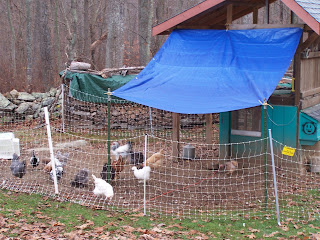Later, I let the dogs out and noticed their interest in something on the ground. I knew it couldn’t be good. I found Billie, beheaded and partially eaten. Naïve perhaps, but I’d not considered that the hawk would kill its prey and eat it on the ground. The rest of the chickens had undoubtedly seen the whole thing and although chickens aren’t the brightest birds, they were badly shaken. It was days before the girls would venture out from cover without first looking skyward and then running to the next safe place. We buried Billie next to Frodo, the red Silkie we lost last year to a hawk on almost the exact same date. Although I miss Billie and the perfect pale green eggs she laid, I realize we’ve been lucky with predators. We have lost one chicken annually to a hawk. We live in a rural area surrounded by woods and populated by coyotes, foxes, raccoons and fisher cats. Unlike our cats, chickens must live outside. We have since added coverage with a tarp to their chicken yard and limit their free-ranging on our property to their enclosure surrounded by electrified net fencing. The girls seem to like the extra overhead and it will also help to maintain a larger snow-free scratching space for them in the winter. The perfect set-up would be an 8-foot high fence with poultry netting over the top, but we’re still resisting the commitment of money and effort it would take to make that happen.
 |
| Chicken Coop Addition |
Meanwhile, we had been kinda-sorta looking for a couple of older chicks to add to the flock. Daughter Kelsey wanted another Silkie and I fell in love with the Mille Fleur colors some of the other breeds come in. Mille Fleur is French for “many flowers”; the coloration of mottled gold, black and white. I found out about the Boston Poultry Show in North Oxford, Massachusetts a couple of weeks ago so we planned a family outing to go chicken shopping. I contacted the person in charge of the show to make sure that there would be chickens available for purchase in addition to those being shown. One of the false assumptions people make who come to cat shows is that all the cats there are for sale (most are not), so I didn’t want to make the same assumption and go to a poultry show for nothing.
The show was being held in an open barn area on a cold Saturday, something a teenage girl doesn’t take preparing for seriously. Kelsey’s Converse-covered frozen feet cut our visit short, but not before we had a chance to admire ginormous chickens who were there for the competition under the category of Large Fowl. "Ginormous" is the only way to describe these birds. We have a Jersey Giant hen who is supposed to reach 10 pounds, but she is a light weight compared to the large fowl breeds at the show who were the height of a hawk and much broader; probably four times as large as my standard breed chickens. The first thought was that a gargantuous rooster like this would be incredible flock protection against the birds of prey. Then again, if he sees people as a threat as many roosters do, that could be a major problem. I don’t want to risk being flogged by a feathered pterodactyl roo.
However, we came to look at bantam (miniature) breeds. We ended up buying a white Silkie for Kelsey and a Mille Fleur Cochin for me, both females, and named them Beaker and Millie respectively. Our backyard flock is now at 14 hens.
We really enjoyed talking chicken to others at the poultry show. They told us about the next show which will be held indoors at the Big E the weekend of January 14-15. For more information, check the website of the Northeastern Poultry Congress. I think a couple of big girls are in our chicken cards next.
 |
| Millie, my Millie Fleur Cochin |
 |
| Beaker, Kelsey's white Silkie |
We buried Billie next to Frodo, the red Silkie we lost last year to a hawk on almost the exact same date.
ReplyDeleteSorry about Billie. Is there any history of hawk attacks compared to annual hawk migration patterns in Connecticut?
The perfect set-up would be an 8-foot high fence with poultry netting over the top, but we’re still resisting the commitment of money and effort it would take to make that happen.
If only you were married to a rich lawyer, you could afford it.
Mille Fleur is French for “many flowers”; the coloration of mottled gold, black and white.
Close. It’s a thousand flowers in English. “Many flowers” is beaucoup de fleurs in French. The origin of the term comes from a popular motif in tapestry, etc. during the Middle Ages, where the background featured many small flowers. The bantam chicken to which you refer is in France called the Barbu D'Uccle. Naturally, it was renamed in the United States to Mille Fleur probably because too many Americans mistook the phrase to mean “barbecue your uncle.” There is no telling how many uncles' lives were taken before someone wised up and renamed the bird. Be proud of your U.S. renaming heritage as you show off your Mille Fleur at your next poultry show, while drinking Stigall beer.
Actually, Howard, it is Stiegl beer (I have some in my fridge awaiting the perfect time for consumption...)
ReplyDelete